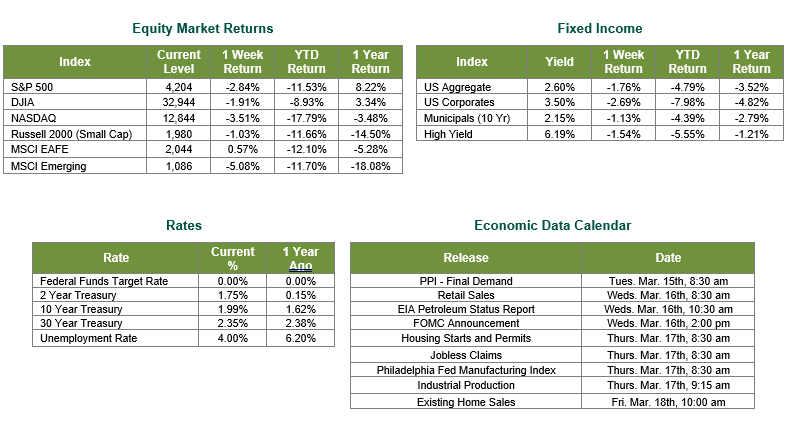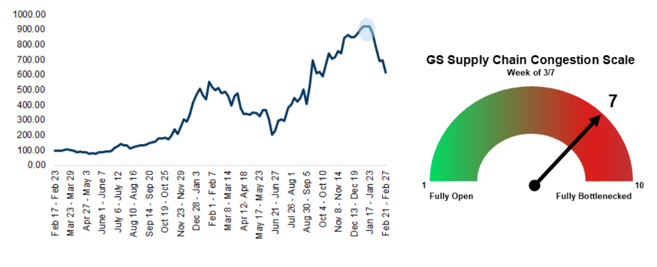
Last Week’s Markets in Review: Inflation and Geopolitical Risks Rise as Fed Meets This Week

Global equity markets moved lower last week. The S&P 500 closed the week at a level of 4,204, representing a loss of 2.84%, while the Russell Midcap Index moved 2.72% lower. Meanwhile, the Russell 2000 Index, a measure of the Nation’s smallest publicly traded firms, returned -1.03%. International equity performance was mixed as developed and emerging markets returned 0.57% and -5.07%, respectively. Finally, the 10-year U.S. Treasury yield finished higher over the week, closing at 2% on Friday.
While the general focus of investors remained largely on Russia/Ukraine last week, in the spotlight for domestic data was the release of the February Consumer Price Index (CPI). Expectations were for a year-over-year gain of 7.9%, a 40-year high, and the actual reported data was spot-on. The data illustrates untamed inflationary pressures the economy was facing, even before the Russian invasion of Ukraine on February 24. As a result, market participants remain ready for the Federal Reserve to use their array of tools to combat high inflation, starting with their first interest rate hike this week. In addition, many anticipated that February would mark peak inflation for the year. Consider one major factor contributing to the bloated figures, supply chain bottlenecks, which appeared to be easing prior to the Russia/Ukraine escalation. As you can see in the left chart from Goldman Sachs supply-chain “Congestion Composite,” there has been a material decline over the past few months. For reference, the scale on the right has been at ten since November of last year.

Despite what appears to be easing supply chain issues and encouraging COVID-19 data, the war overseas is now likely to keep inflation high in the months ahead, specifically regarding energy and certain agricultural commodity prices. While Russia’s contribution to global gross domestic product (GDP) is relatively small, they are a major player in the commodities markets. We’ve all seen the impacts at the gas pump, but the effects may span further into consumer spending, sentiment, and higher input costs for businesses. There is also the potential for further disruption to shipping lanes and a re-elevation of the aforementioned supply bottlenecks.

This conundrum further complicates the Fed’s approach to controlling inflation using balance sheet reduction tactics and interest rate increases. In our view, the war introduces the possibility that if the Fed raises rates too quickly, tight monetary policy obstructs the growing, yet slowing, domestic economy. We eagerly await information from the Fed this week. We will likely see interest rates move higher, receive updated comments on their plans for shrinking the size of their balance sheet, and get a fresh summary of economic projections.
As always, we suggest working with experienced financial professionals to help navigate the complex capital markets to build and manage the asset allocations within portfolio strategies consistent with an investor’s objectives, timeframe, and risk tolerance.
Best wishes for the week ahead!
Sources for data in tables: Equity Market and Fixed Income returns are from JP Morgan as of 3/11/22. Rates and Economic Calendar Data from Bloomberg as of 3/11/22. International developed markets measured by the MSCI EAFE Index, emerging markets measured by the MSCI EM Index, U.S. Large Cap defined by the S&P 500. Sector performance is measured using the GICS methodology.
Disclosures: Past performance does not guarantee future results. We have taken this information from sources that we believe to be reliable and accurate. Hennion and Walsh cannot guarantee the accuracy of said information and cannot be held liable. You cannot invest directly in an index. Diversification can help mitigate the risk and volatility in your portfolio but does not ensure a profit or guarantee against a loss.
Diversification can help mitigate the risk and volatility in your portfolio but does not ensure a profit or guarantee against loss.
Investing in commodities is not suitable for all investors. Exposure to the commodities markets may subject an investment to greater share price volatility than an investment in traditional equity or debt securities. Investments in commodities may be affected by changes in overall market movements, commodity index volatility, changes in interest rates or factors affecting a particular industry or commodity.
Products that invest in commodities may employ more complex strategies which may expose investors to additional risks.
Investing in fixed income securities involves certain risks such as market risk if sold prior to maturity and credit risk, especially if investing in high yield bonds, which have lower ratings and are subject to greater volatility. All fixed income investments may be worth less than the original cost upon redemption or maturity. Bond Prices fluctuate inversely to changes in interest rates. Therefore, a general rise in interest rates can result in the decline of the value of your investment.
Definitions
MSCI- EAFE: The Morgan Stanley Capital International Europe, Australasia and Far East Index, a free float-adjusted market capitalization index that is designed to measure developed-market equity performance, excluding the United States and Canada.
MSCI-Emerging Markets: The Morgan Stanley Capital International Emerging Market Index, is a free float-adjusted market capitalization index that is designed to measure the performance of global emerging markets of about 25 emerging economies.
Russell 3000: The Russell 3000 measures the performance of the 3000 largest US companies based on total market capitalization and represents about 98% of the investible US Equity market.
ML BOFA US Corp Mstr [Merill Lynch US Corporate Master]: The Merrill Lynch Corporate Master Market Index is a statistical composite tracking the performance of the entire US corporate bond market over time.
ML Muni Master [Merill Lynch US Corporate Master]: The Merrill Lynch Municipal Bond Master Index is a broad measure of the municipal fixed income market.
Investors cannot directly purchase any index.
LIBOR, London Interbank Offered Rate, is the rate of interest at which banks offer to lend money to one another in the wholesale money markets in London.
The Dow Jones Industrial Average is an unweighted index of 30 “blue-chip” industrial U.S. stocks.
The S&P Midcap 400 Index is a capitalization-weighted index measuring the performance of the mid-range sector of the U.S. stock market, and represents approximately 7% of the total market value of U.S. equities. Companies in the Index fall between S&P 500 Index and the S&P SmallCap 600 Index in size: between $1-4 billion.
DJ Equity REIT Index represents all publicly traded real estate investment trusts in the Dow Jones U.S. stock universe classified as Equity REITs according to the S&P Dow Jones Indices REIT Industry Classification Hierarchy. These companies are REITs that primarily own and operate income-producing real estate.



